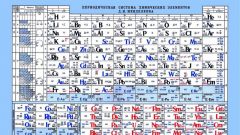You will need
- - the range;
- pencil;
- - The Periodic Table.
Instruction
1
Take the periodic table, and with a ruler draw a line that starts in the cell with the element Be (Beryllium), and ends in a cage with the element At (Astatine).
2
The items that will be on the left of this line are metals. And the "below and to the left" is the element, the more pronounced metallic properties it has. It is easy to verify that in the periodic table so metal is France (Fr) is the most active alkali metal.
3
Accordingly, those elements which are right of the line, have properties of nonmetals. And here, too, a similar rule applies: the more "up and to the right" of the line is the element, the more powerful it is nonmetal. The element in the periodic table is fluorine (F), the strongest oxidizer. He is so active that the early chemists gave him a respectful, though unofficial, nickname: "All razrezami".
4
There may be questions like "But what about those items that are on the line or very close to it?". Or, for example, "the"top" of the line are chrome, manganese, vanadium. Is it a nonmetal? After all, they are used in the production of steel as alloying additives. But we know that even small impurities of non-metals make the alloy fragile." The fact that the elements located on the line (for example, beryllium, aluminum, titanium, germanium, niobium, antimony) are amphoteric, that is, a dual nature.
5
As for example, vanadium, chromium, manganese, are the properties of their compounds depends on the oxidation state are the atoms of these elements. For example, such higher oxides like V2O5, CrO3, Mn2O7, have pronounced acidic properties. That is why they are the seemingly "illogical" places in the periodic table. In pure form these elements, of course, are the metals and have the properties of metals.


